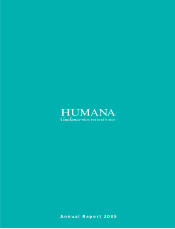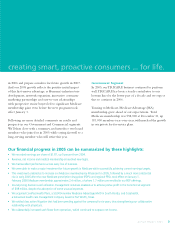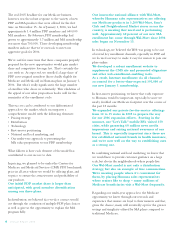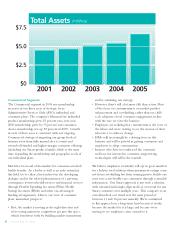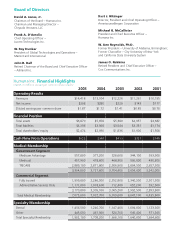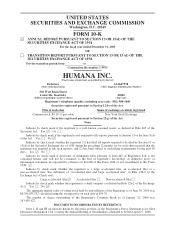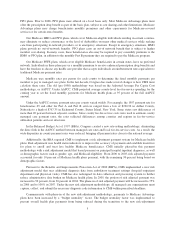Humana 2005 Annual Report Download - page 6
Download and view the complete annual report
Please find page 6 of the 2005 Humana annual report below. You can navigate through the pages in the report by either clicking on the pages listed below, or by using the keyword search tool below to find specific information within the annual report.The real 2005 headline for our Medicare business,
however, was the robust response to the variety of new
PDP and MA products that were offered for the fi rst
time on November 15. As of January 1, 2006, we had
approximately 1.4 million PDP members and 640,000
MA members. By February, PDP membership had
grown to approximately 1.7 million and MA membership
was more than 700,000. These developing membership
numbers indicate that we’re on track to meet our
aggressive goals for 2006.
We’ve said for some time that those companies properly
prepared for the new opportunities would gain market
share and competitive leverage fast. That’s certainly the
case with us. As expected, we enrolled a large share of
PDP auto-assigned members (those dually eligible for
Medicare and Medicaid) in Humana plans on January 1,
2006. But what’s really signifi cant is the large number
of enrollees who chose us voluntarily. This validation of
the appeal of our value proposition bodes well for the
remainder of the enrollment cycle.
This success can be attributed to our differentiated
approach to the market, which encompasses a
comprehensive model with the following elements:
• Pricing strategy
• Distribution
• Technology
• First-mover positioning
• National and local marketing, and
• Our multi-year approach to presenting the
MA value proposition to our PDP membership.
What follows is how each element of the model has
contributed to our success to date.
In pricing, we planned to be under the Centers for
Medicare and Medicaid Services (CMS) PDP benchmark
price in all areas where we would be offering plans, and
to price to ensure the attractiveness and profi tability of
our products.
Our initial PDP market share is larger than
anticipated, with good member diversifi cation
among our three plans.
In distribution, we believed face-to-face contact would
cut through the confusion of multiple PDP plan choices
as well as give us the opportunity to explain the MA
program fully.
Our innovative national alliance with Wal-Mart,
whereby Humana sales representatives are offering
our Medicare products in 3,200 Wal-Mart, Sam’s
Club and Neighborhood Market stores across the
country, is meeting that need and is performing
well. Approximately 60 percent of our new MA
enrollment has come through Wal-Mart since 2006
sales began on November 15.
In technology, we believed the Web was going to be one
of several key enrollment channels, especially in PDP, and
we focused on ways to make it easy for seniors to join our
plans online.
We developed a robust enrollment website to
supplement the CMS site and promoted eSignature
and other web-enrollment-enabling tools.
As a result, Internet enrollment via all channels
accounted for a better-than-expected 391,000 of
our new January 1 membership.
In fi rst-mover positioning, we knew that early exposure
to Humana would be important, especially because we
nearly doubled our Medicare footprint over the course of
the past 12 months.
We expanded our private fee-for-service offerings
from 12 to 35 states in 2005 to prepare the way
for our 2006 expansion efforts. Starting in the
summer, our “Let’s Talk” mobile RVs visited 350
cities, while garnering 60 million news media
impressions and raising national awareness of our
brand. This is especially important since there are
few established national brands in health insurance,
and we’re now well on the way to establishing ours
as a strong one.
In combining national and local marketing, we knew that
we would have to provide customer guidance on a large
scale, but also in the neighborhoods where people live.
Our Wal-Mart model is not only a distribution
strategy, but also an example of true consumerism.
We’re meeting people where it’s convenient for
them, by placing Humana sales representatives
where seniors like to shop – many millions of
Medicare benefi ciaries visit a Wal-Mart frequently.
Regarding our multi-year approach to the Medicare
opportunity, we knew through our research and
experience that seniors are loyal to their insurers and that,
given the chance, many will eventually opt for the greater
savings and simplicity offered by MA plans compared to
traditional Medicare.
4 Annual Report 2005

